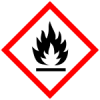The Producer has a plan to phase out by 2024 pesticides listed in category 2 of the Globally Harmonized System of Classification and Labelling of…
Coalition status
Details
Toxicty
GHS safety labels
- H250

Catches fire spontaneously if exposed to air
Class: Pyrophoric
Subclass: Liquids - H330

Fatal if inhaled
Class: Acute Toxicity
Subclass: Inhalation - H330

Fatal if inhaled
Class: Acute Toxicity
Subclass: Inhalation - H341

Suspected of causing genetic defects (state route of exposure if it is conclusively proven that no other routes of exposure cause the hazard)
Class: Germ Cell Mutagenicity - H341

Suspected of causing genetic defects (state route of exposure if it is conclusively proven that no other routes of exposure cause the hazard)
Class: Germ Cell Mutagenicity - H350

May cause cancer (state route of exposure if it is conclusively proven that no other routes of exposure cause the hazard)
Class: Carcinogenicity - H350

May cause cancer (state route of exposure if it is conclusively proven that no other routes of exposure cause the hazard)
Class: Carcinogenicity - H361

Suspected of damaging fertility or the unborn child (state specific effect if known)(state route of exposure if it is conclusively proven that no other routes of exposure cause the hazard)
Class: Toxic to Reproduction - H361

Suspected of damaging fertility or the unborn child (state specific effect if known)(state route of exposure if it is conclusively proven that no other routes of exposure cause the hazard)
Class: Toxic to Reproduction - H372

Causes damage to organs (state all organs affected, if known) through prolonged or repeated exposure (state route of exposure if it is conclusively proven that no other routes of exposure cause the hazard)
Class: STOT
Subclass: Repeated exposure - H372

Causes damage to organs (state all organs affected, if known) through prolonged or repeated exposure (state route of exposure if it is conclusively proven that no other routes of exposure cause the hazard)
Class: STOT
Subclass: Repeated exposure - H400

Very toxic to aquatic life
Class: Aquatic
Subclass: Acute - H400

Very toxic to aquatic life
Class: Aquatic
Subclass: Acute - H410

Very toxic to aquatic life with long lasting effects
Class: Aquatic
Subclass: Chronic - H410

Very toxic to aquatic life with long lasting effects
Class: Aquatic
Subclass: Chronic
